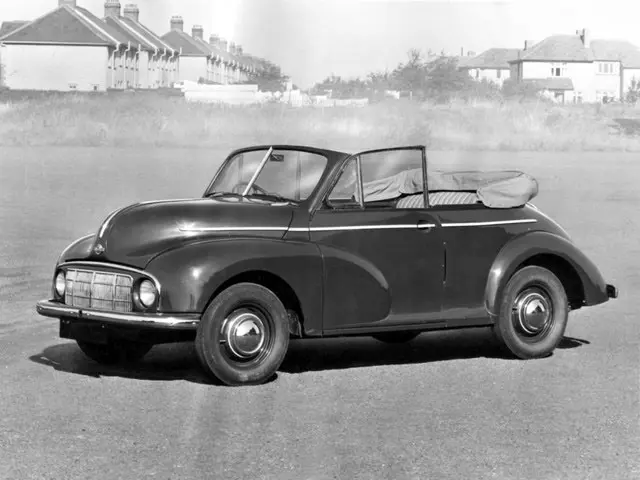75 years of the Morris Minor by Andrew Roberts
26 September 2023
The 1949 Morris models are being kept secret until today. We believe an aerodynamic car with the four-cylinder side-valve engine used in the former “Eight,” known as the Morris Minor, will be on show, together with larger models, one of which will be called the Morris Oxford. Go and see for yourselves!
So reported Motor Sport about Britain’s first post-war Motor Show in 1948. Those who paid ten shillings to gain early admission to Earls Court on the 27th of October could marvel at the new Morris Minor MM saloon and tourer - https://www.youtube.com/watch?v=IdSu6S_91R4. It was not just that the specification included independent front suspension and rack & pinion steering; they also bore no resemblance to the outgoing Eight. Aside from the 918cc side-valve engine and the badging, the Minor appeared wholly new.

To have an idea of how startling the Minor must haves seemed to a 1948 motorist, simply compare it to Ford’s pre-war-looking Anglia E494A. In terms of rivals from overseas, neither the VW Beetle nor the Citroën 2CV would be officially available in the UK until 1953.
The MM cost an affordable £358 10s 7d in either saloon or Tourer guise. The colour choices ranged from black and maroon to Platinum Grey and Roman Green, and extras included a second windscreen wiper. However, most visitors to Stand 163 had probably already noted the Morris advertisement’s warning - “Priority for Export orders”.
In the aftermath of the war, British car makers reserved the bulk of production for overseas. Britain’s motor manufacturers needed to export 75% of their output to be eligible for a steel quota. The domestic waiting list consequently ran for at least two years and profiteering was rife. Even you had the good fortune to obtain a new MM there remained the issue of the used car Covenant. In 1948, the owner of a new model had to sign an agreement that they would not sell it within twelve months.
But the Minor anticipated a future free from ration books, queuing in the rain outside the grocer’s shop and coupons for ‘Pool Petrol’. The automotive press was bowled over, and when Autocar tested the latest Morris, they stated:
Now and again, it happens that circumstances bring a person suddenly into prominence, and he or she instantly becomes a favourite in the public affections. Something similar occurs sometimes with new cars, and it is likely to happen.to the new Morris Minor.
Their counterparts at The Motor thought “there has been nothing like it offered in the economy class previously” and concluded:
The highest tribute to the Minor is that a variety of drivers hitherto enthusing over larger and faster cars suddenly began to feel that this grown-up baby could fulfil all their requirements and double their mpg figures. The real lament is that, ideally suited though it is to home needs, most of the new Minors will go to keen buyers abroad.
Such praise tends to mask that the Nuffield Group did not expect the Minor to be their post-war mainstay. The MM was the entry-level model of a new five-car post-war line-up, with the other members of the family ranging from the Morris Oxford MO and Six MS to the Wolseley 4/50 and 6/80. Management at Cowley believed the Oxford would be their major export winner, but it was “The World’s Supreme Small Car” that attracted attention across the globe.
As Autocar reported from Earls Court: “the ants were round the honeypots on wheels. Four at a time they could be seen trying the seats of the new Cowley Minor”. Meanwhile, the London Evening Standard reporter wrote, with some incredulity, that “women visitors were everywhere - leaning over rails, studying moving chassis and engine parts, stepping in and out of cars, and asking severely practical questions”.
This new Morris Minor clearly inspired some most outrageous behaviour.
